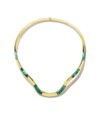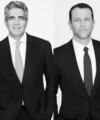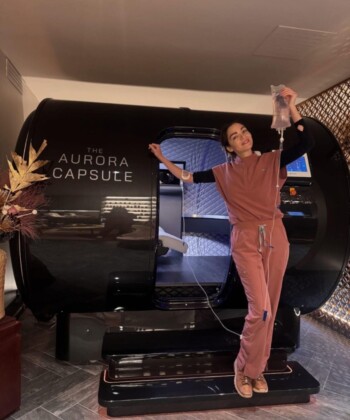Think about a handsome man. What does his face look like? If you’re of a certain age (between your twenties and fifties), living in a certain metropolitan area (New York, L.A., Miami), you’re probably imagining someone with an angular jaw, chiseled cheekbones and washboard abs. It’s as important to note the things you’re not conjuring—droopy eyelids, a turkey neck, forehead lines. Ten, maybe 20 years ago, the ravages of time were the concern of a small (mostly gay) group of men who frequented plastic surgeons and practitioners of noninvasive dermatology to turn back the clock. These days, however, it’s not just the men at the vanguard of trends who are getting work done: It’s your realtor, your barber, your attorney.
Take Chad Asnes, the 40-year-old owner of a personal-training studio in Wellesley, Massachusetts. Asnes isn’t the type to jump from one fad to the next, but when it comes to his appearance, he considers both surgical and noninvasive procedures simple maintenance. “I think men are just as vain as women,” he says, “and being in a society that’s superficial, I’m just trying to slow down the aging process and keep up with the competition.” Since first meeting with his doctor, New York plastic surgeon Dr. Douglas Steinbrech, Asnes has had Botox injections around his eyes and on his forehead, buccal-fat removal surgery to reduce fullness in the cheeks and fillers in the chin to create a stronger jaw. “I’ve liked the results; it’s not drastic,” says Asnes. “I’d like to look into some rhinoplasty”—a nose job—“at some point too.” Asnes estimates he’s spent approximately $16,000 on various cosmetic enhancements.
According to the American Society for Aesthetic Plastic Surgery, between 2010 and 2015 there was a 43 percent increase in the number of men who underwent both surgical and nonsurgical procedures. Since ASAPS began collecting data in 1997, there’s been a 273 percent rise in the amount of procedures performed on men. “The first thing that men complain about when they come to me is the area around their eyes,” says Dr. Paul Jarrod Frank, a Hollywood-handsome cosmetic dermatologist based in Manhattan. “They start to notice they’re tired or have bags, so what we do is use injectables like Botox or fillers that can help smooth out the area.” Unlike traditional plastic surgery, which involves incisions and recovery time, dermal fillers—a variety of which have commercial names such as Restylane, Juvéderm or Belotero—provide temporary volume and smoothness before being naturally absorbed by the body and start at approximately $1,000 for the chin and $2,000 along the jaw. Dr. John Diaz, a Beverly Hills plastic surgeon, notes that clients also come in looking for help with saggy necks, something he can now treat with CoolSculpting, a form of noninvasive targeted fat reduction that uses cold temperatures to freeze and kill fat cells.
The shift among men is drawing attention on the dating landscape as well. Jennifer Feng, a 31-year-old single woman in Manhattan, has noticed that guys in New York have been becoming more attractive. “You go to a downtown bar, and you notice all of a sudden every guy has
this chiseled face and great haircut and nice clothes,” she says. “It’s like, when did this happen?” As with the advent of streaming, clickable food delivery or any sentence that begins “It’s like the Uber of” literally anything, blame the changing technological landscape.
“We live in a social-media-driven world now,” says Frank, “and everything is seen on your phone, whether you’re a teacher, a stockbroker or a hedge funder. What MTV did to the music industry in the ’80s, Instagram is doing to all men.” Much has been said about the fact that everyone is a celebrity now, but it’s true that within one’s social (media) circle, every dinner, gathering or event is a potential “appearance,” our friends, the paparazzi, hounding us as we’re scarfing down linguine. It’s not even just men’s awareness that they’re being photographed, however, that’s altering their outlook; it’s the competition, as Asnes notes, that arises from keeping tabs on everyone else. “Because of social media, men are now also exposed to many more people within their peer group than before,” says Diaz, “and so you have 50-year-olds seeing guys their age with six packs or chiseled jaws. If they’re newly divorced or just single men, you can bet they’re going to want to do something about it.” Today, peer pressure isn’t just coming from the individuals you interact with on a daily basis, but also from the friends of friends of friends whose photos happen to pop up on your “Discover” tab.
Consider also our shifting standards of male beauty. Take, for example, the Chrises Hemsworth, Evans and Pratt of the summer multiplex, each of whom has a relaxed, achievable appeal. Ten years ago, we may have been discussing the rise of the metrosexual (the one who waxed and tanned and pampered every inch of his body), but what drew attention—and mockery—to that style was how unnaturally belabored it was. How many men in their thirties, forties and fifties could be expected to emulate the aesthetic ideals we associated with prepubescent boys?
Today, we’re in the age of the lumbersexual, of Tom Hardy, of Idris Elba—rugged, tousled men who could eat Zac Efron and Robert Pattinson for breakfast. It’s a look the average Joe, rather than a Hedi Slimane muse, can aspire to, and it’s changing the kinds of procedures that men are after. Gone is the preference for soft, almost feminine features. “When I got my chin done,” says Asnes, “Dr. Steinbrech and I talked a lot about movie stars as strong visuals of what we wanted to achieve. It was about the chin of Tom Brady or the jaw of Brad Pitt. Something subtle but strong.” Steinbrech notes that men are seeking him out in search of that classic superhero look—they come in requesting the square jaw of Matt Bomer or male supermodel Sean O’Pry (he of Taylor Swift’s “Blank Space” video) the way you might imagine women rushing to aestheticians in search of that bushy Cara Delevingne brow.
Male beauty standards have become so relaxed that even that traditional signifier of slovenliness—the full beard—has become aspirational. Dr. Jeffrey Epstein, a plastic surgeon with practices in both New York and Miami, says that one of his newest and most popular procedures is the beard implant, in which he uses hair-transplant technology to help men create the ideal facial hair. (Filling in a beard starts at $4,500 and goes up to $16,000 for a full transplant.) It’s so trendy he does two or three a week. “Yeah,” he says, “beards are so hot right now.” As in fashion, however, where everything new is old, the of-the-moment facial hair has its historical antecedent. Just ask Samson.
Doctor Nose Best
Top cosmetic surgeons with a burgeoning male clientele, these four practitioners exhibit some of the physical traits their new patients request
WHO TO SEE:
Dr. John Diaz, Beverly Hills
“I’m seeing an increase in neck lifts, to make the jawline and neckline more angular, structured and rejuvenated,” he says.
Dr. Paul Jarrod Frank, New York City
“Men are into superhero images from their youth,” he explains. “In my field, the best results come from a combination of small things.”
Dr. Douglas Steinbrech, New York City
“[Patients] tend to be guys who are single,” he says, “and what they’re looking for is a higher, more Nordic cheekbone.
Dr. Jeffrey Epstein, New York City and Miami
“More men are realizing as they get older—they start losing some of their eyebrows and want to restore that fuller, thicker look,” he says.






































